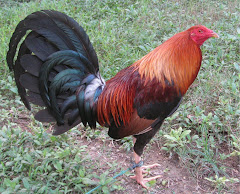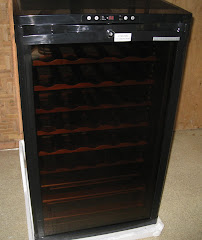
Contrary to what animal rights movement’s claim that cockfighters forced the gamefowl to fight, the truth was thousands of years ago, chickens already fought in the wild.
Indeed, they were domesticated for the purpose of the sport of chicken fighting. Because, even then, it was their nature, to fight.
But, behold! The chicken also did lay nutritious eggs, and did serve as delicious meal. Thus, the ingenious man, created breeds of chickens for laying and breeds of chickens for meat.
Notwithstanding that the brave fighting chicken served these additional purposes as well.
Now, here’s a technology that has come full cycle. With all the scientific advancement, we found ourselves moving forward to the past.
Afterall, the pastured fighting chicken is the best fit for fighting, boasts of the most delicious meat, and lays the most nutritious eggs.
Not a bad proposition.
The Philippine native chicken is the common fowl found in the backyards of most rural households. It is a mixture of different breeds and believed to have descended from the domesticated red jungle fowl.
Pilipino native chicken are raised under the free- range system of management. Under this system of management, the chickens are allowed to forage and look for their own food.
The raising of native chickens is an integral part of the farming systems of the Filipino farmers as they are the main source of eggs and meat for backyard farmers. Each household raise about five to 100 heads of native chicken.
Native chickens are well known for their adaptability to local agro-climatic conditions, hardiness, ability to utilize farm-by-products and resistance to diseases. Moreover, they require minimal care, management and inputs.
Meat and eggs of native chickens are preferred by many Filipinos over the same products from commercial poultry because of their taste, leanness, pigmentation and suitability to Filipino special dishes. Moreover, native chicken meat and eggs are priced higher than those coming from commercial poultry.
With today’s food and health concerns, native chickens produced organically or with lesser vitamins, minerals and antibiotics in their body is the “in” thing. Organic native chicken is gaining popularity. The meat produced out of this chicken commands higher price, has sociocultural relevance and there is a better meat quality that is tender, meatier, and tastier..
Its cousin, the American gamefowl, which also originated from the red jungle fowl, raised in similar manner as the native chicken has all the advantages of the Pilipino native chicken in terms of meat and egg production. However, the males, which are gamefowl and thus, could be used for fighting, command up to 20 times the price of a male Pilipino chicken. Not a bad proposition, at all.The hens can be sold as meat, (killed and sold per kilo) or breeders (alive and for higher prices.)
With this idea in mind RB Sugbo Gamefowl Technology integrated gamefowl management and free-ranged and pastured chicken farming to come up with a technology suited for production of an all-purpose chicken. RB Sugbo GT developed strains of gamefowl appropriate for the purpose-- the Zugbus.
If one can survive or even make a business out of raising Pilipino native chicken, why not with the special strains of American gamefowl?
What is Pastured Poultry?
Pastured Poultry relies on raising chickens directly on green pasture. The model has been developed over the last twenty years and allows the birds to receive a significant amount of pasture forage as feed. The birds are kept on fresh pasture, which allows the birds to be raised in a cleaner, healthier environment. Pastured poultry is raised the old fashioned way; on fresh green pasture and wholesome grain. The Pasture Poultry offers ecological and nutritional advantages."
The fundamentals of this system are
(1) portable buildings and yards; (2) fresh forage; (3) birds moved to fresh pasture paddocks daily, or almost daily.
The green material of fresh forage provides B vitamins as well as carotenes, some of which the chicken turns into vitamin A. Omega-3 fatty acids in the forage end up in the fat. Exposure to sunlight ensures that the fat will also contain vitamin D. Producers have created ingenious portable poultry structures--Chicken houses on wheels and skids now dot the countryside as a method of production that finally meets the full social, nutritional and physiological needs of poultry.
These birds actually live on the ground, catching bugs and scratching in the soil. Every day is a new discovery of salad on a fresh paddock so the birds do not get bored and begin eating one another, as they do in typical confinement factory houses.
Research on the essential fatty acids has not been out very long, so it is no wonder that it is just now getting into the popular press. The gist of the discovery that is coming to light is that, by cleverly concentrating animal feeds using grains, instead of grasses, man has unwittingly led himself down the road to degenerative disease.
This is because our essential fatty acids, which control myriad bodily functions, fall into two families: the Omega-3's and the Omega-6's. The Omega3 group comes from the leaves of green plants (and plankton in the ocean), while the Omega6 group comes from the seeds (for example, grain used in animal feeds). Animals that eat quantities of green plants have very high levels of Omega3. Conversely, animals fed largely on grain, which includes virtually all American feed animals except lamb, are very high in Omega6.
We should have approximately equal amounts of Omega3 and Omega6 in our bodies, or at maximum, not much more than twice the Omega6 as Omega3. But most have ten or twenty times more Omega6 than Omega3, a condition that leads to all sorts of degenerative disease. The way to rectify this fatty acid imbalance is to consume animal products raised on grass or plankton. All sea life is ultimately based on plankton, so all seafood is balanced in favor of Omega3. The fattier the fish, the more Omega3. Lamb is almost all grass-fed, so that is another fine source of Omega3. Conveniently, simply adding flax seed to poultry diets increases their Omega3 concentration dramatically.
Poultry raised on open grass, instead of in over-crowded lots, are high in beneficial fats and other factors that lower cholesterol and greatly reduce degenerative disease in the consumer! Eating large proportions of living green plants, while foraging for insects and seeds and myriad other natural commodities that science hasn't identified yet, and with minimal need for medication, grassfed animals create more vibrant health than other poultry. Moreover, the meat and eggs are incredibly tasty compared to general market chicken.(Primer on this technology will soon be published in Tilaok/RB Sugbo free publications)








